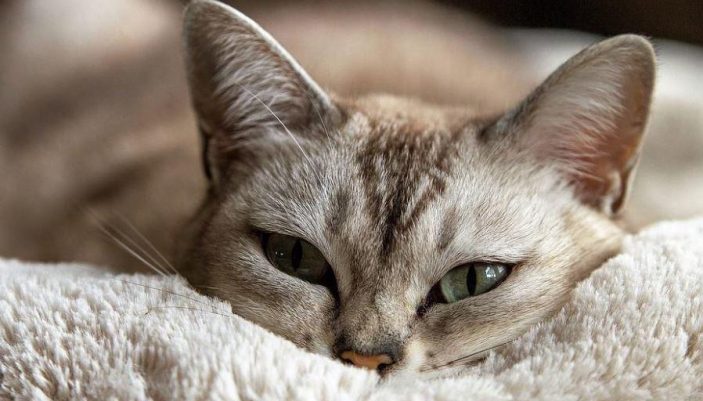Thiamine or vitamin B1 is a water-soluble vitamin, part of the B complex vitamins which also has other members including riboflavin (B2), niacin (B3), pantothenic acid (B5), pyridoxine (B6), biotin(B7) folic acid (B9) and cobalamin (B12).
Thiamine is naturally available in some foods, can be made as a dietary supplement or for medical purposes.
Some vitamin B1 rich foods include yeast, meat, whole grains (cereals), legumes (peas and beans), nuts, pork, fish, seafood, poultry, and eggs.
From the list of foods rich in vitamin B1, it is possible to assume that being a carnivore, a cat has unlimited choices of foods to satisfy its need for this vitamin. However, one food they like that can counteract thiamine is fish.
Therefore, always ensure these pets have fish in moderation. We also noted that fish diets especially those with fish oil or PUFAs can also cause vitamin E deficiency in cats.

Functions of vitamin B1 in cats
It is an essential part of a cat’s diet which must be availed in the required amount since cats cannot synthesis thiamine. Otherwise, these pets may show deficiency signs.
Firstly, when “in the form of thiamine diphosphate (TDP), it has a critical role as a cofactor in carbohydrate metabolism, in the production of nucleotides and of nicotinamide adenine dinucleotide (NADH), and for nervous system function,” notes the Journal of Veterinary Sciences
Note that the pentose phosphate pathway and citric acid cycle metabolism depend on thiamine and they are vital in producing energy utilized by the central nervous system. If energy is generated anaerobically, lactic acid will accumulate in the central nervous system and consequently result in neuron loss.
Secondly, whereas not well studied, other forms including the free thiamine, thiamine monophosphate, and triphosphate may help in nervous functions. This is why calming supplements like VetriScience Laboratories Composure, Calming Formula for Cats or Pet Naturals of Vermont 30 Count Calming Behavioral Support Soft Chews for Dogs and Cats have thiamine.
Thiamine deficiency in cats causes
Deficiency can arise from several factors including the following:-
- Homemade or commercial diets that don’t contain adequate amounts including only meat diets.
- The use of sulfur dioxide as a preservative for fresh meat cat food as it blocks vitamin B1 absorption. In fact, some products marketed as fresh pet meat, mince, or processed ones may have such preservatives.
- Being water-soluble, excessive urination (diuresis) means that it will be excreted away.
- It may occur after “extensive surgical resection of jejunum and ileum,” notes PetMD.com
- Any diseases or conditions that cause nutrient absorption or assimilation problems
- Prolonged starvation due to poor appetite
- Thiamine destruction during food processing including cooking often results in inadequate amounts including cooking food in water and some canned foods.
- Thiaminase in some raw fish such as herrings, carp, catfish, cod, etc., destroys vitamin B1
Signs and symptoms of a deficiency
If not detected early, vitamin B1 deficiency can be life-threatening. If this pet is on a diet deficient of this vitamin, signs might begin showing after 30-40 days but progress very fast. Some of the things that may signal a deficiency include the following:
- The first symptoms often noted after about two weeks include vomiting and other gastrointestinal problems and excessive drooling. Also, reduced appetite and weight loss may be noted in some cats.
- Secondly, this pet may have vestibular and neurological problems which according to Open Farm include but not limited to “incoordination, circling, head tilt, dilated pupils, stupor, seizures, and arching of the head, neck, and spine backward.”
- Finally, ventriflexion characterized by your feline friend curving towards the floor or curling his or her neck as well as poor growth and coprophagy.
If left untreated, the condition can be fatal and your feline friend may end up with “semi-coma, persistent vocalization, opisthotonus, and death,” states Bsava.com.
Diagnosis
Your vet will look at the various clinical signs, ask about your feline friend’s history especially with regards to his or her diet, symptoms duration, and test the levels of thiamine in its blood.
According to healhtypets.mercola.com some of the common tests include the “electrolyte transketolase activity assay, and the other is high-pressure liquid chromatography.”
Also, complete blood count, blood chemistry profile, urinalysis as well as an MRI brain scans to seen changes and presence malacia and bilaterally systematical hemorrhage in susceptible brain areas may also be conducted including at post-mortem.
Treatment – thiamine supplements for cats
Treatment will involve going for cat foods high in thiamine as well as considering vitamin B1 supplements for cats such as those administered orally (mainly in tablet and powder form) or through intramuscular or subcutaneous injections.
There are many veterinary preparations available. For instance, synthetic supplements may have thiamine hydrochloride or thiamine mononitrate.
Typical vitamin B1 dosage is 10-25mg given after every 12-24 hours continuously until the symptoms resolve and this can be followed by oral supplementation of 10mg/kg of cat weight daily for 21 days.
Once supplemented, your pet will recover quickly, i.e., between a few hours to about two days since this vitamin is rapidly absorbed.
Prevention
Always ensure you go for high-quality cat food with enough amounts of thiamine. AAFCO recommends amounts of about 5mg/kg of cat food. Over supplementation isn’t a big issue since it will be excreted via urine being water-soluble.
Secondly, avoid recalled foods (FDA has the list of recalls or you can look at AVMA), raw fish foods, canned foods (often associated with inadequate vitamin B1 amounts as well as some dried foods especially when exposed to moisture, heat or humidity. Also, avoid unbalanced diets
Side effects and interactions
- Anaphylaxis may result if thiamine is administered intravenously. Consider dilution and administer it slowly in case of an IV.
- Pregnant animals may adversely be affected. Use it only if it is very necessary.
- Besides enhancing neuromuscular blocking agents, no other interaction has been reported.
Note that vitamin B1 is at times an adjunctive in ethylene glycol and lead poisoning treatment.
